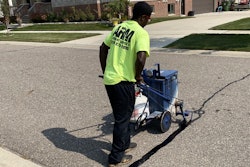
No matter the initial quality of asphalt pavement, it will need preventative maintenance over its service life to continue to provide safe, viable and beautiful roads. Additionally, pavement preservation can help maximize road budgets. Paving experts estimate that, depending on road conditions, every $2 spent on pavement preservation can save $4-$18 on future costs.
Sealing cured asphalt can help the pavement resist oxidation from the sun, revitalize its surface and provide a protective layer against water, oil and salt. As such, sealing is a worthwhile investment for asphalt roads that are still structurally viable but are showing signs of age. When it comes to sealing, contractors generally have two options: sealcoating or using an asphalt chip seal.
While sealcoating seems to be an initially less expensive option, it cannot repair cracks and other forms of distress because it is a surface treatment that only mitigates water and other chemical penetration. It has no structural strength of its own and will need to be reapplied every other year or so. On the other hand, asphalt chip seal not only provides similar protection, but it also can reconstruct more distressed pavements (including those with minor alligator cracking). It can also last up to five times longer than sealcoating.
Benefits of Lightweight Aggregate Asphalt Chip Seal
Chip seal made with lightweight aggregate, such as expanded shale, clay or slate (ESCS) can provide a cost-effective surface treatment that both repairs roads and improves their safety and durability. Because ESCS has a network of unconnected voids, it provides an increased surface area to bond to the emulsion. As such, it can withstand high-speed traffic and normal wear-and-tear that pavements undergo—resulting in a surface treatment that can last up to 10 years.
The voids also increase the retention rate of aggregates, which can lead to a significant reduction of application and maintenance costs. For example, in 2017, the Carbon County Road Department reported that the increased retention rate of lightweight aggregate, as well as reduced fuel costs due to the material’s lower density, resulted in more than$300,000 in savings annually.
In addition, these voids lower the aggregate density, meaning should a patch of pavement be kicked up the force it would inflict on windshields and headlights is much lower than conventional aggregates. In fact, after switching to lightweight aggregate asphalt chip seal to repair Interstate-84, representatives from the Utah Department of Transportation (UDOT) stated they have not had a single claim or complaint about damage. They continued, “This is unheard of for a chip seal.”
The voids also help asphalt chip seal resist polishing for long-term skid resistance. This contributes to safer roads in both wet and dry conditions. And despite the long-term skid resistance, the aggregate creates a more uniform road surface, ideal for vehicles and bicycles alike. Using lightweight aggregate chip seal can be an efficient means of preventative maintenance, if project managers observe the following steps as a best practice guide.
Step 1: Survey Site and Have a Pre-Construction Meeting
Before starting a chip seal project, it is important to survey the site to ensure it is in good enough condition for preventative maintenance. While chip sealing can repair some damage, it is not recommended for unsealed cracks greater than a quarter of an inch, rutting deeper than 1 inch and medium- to high-severity alligator cracking. If a site has these damages, sealing and repair will need to take place prior to the placement of asphalt chip seal.
In addition to surveying the site, it is recommended to have a pre-construction meeting, so all parties have clear and defined expectations. This includes detailing any pre-application maintenance that needs to occur, confirming timelines, determining application rates and whether a site needs a single or double layer. Taking these steps before starting a project increases both the effectiveness of asphalt chip seal and the overall satisfaction with the finished project.
Step 2: Prepare the Site
The next step is to prepare the site for chip sealing. For highly-distressed sections of pavement, contractors should have crews seal any large cracks, fill ruts and repair other damages roughly three to six months prior to the application of asphalt chip seal. This timeline allows these repairs to cure fully, creating a suitable foundation for the asphalt chip to adhere to.
On the day the chip seal is to be placed, the road should be thoroughly cleaned. This includes washing off mud and sweeping away any dirt and debris from the pavement surface. If washing is required, the road should be allowed to dry completely. This step helps the emulsion stick directly to the old surface—reducing the risk of misapplication.
It should also be noted that ambient temperature should sit between 55 degrees and 90 degrees Fahrenheit (F), and the pavement temperature should be 70 degrees F and rising. Maintaining these temperatures on the day the chip seal is placed will help the material perform to its maximum capabilities.
Step 3: Place Chip Seal
Once the preparations have taken place, contractors can place the chip seal. First, contractors should dial in the proper shot rate of emulsion based on site conditions—generally between 0.33 and 0.38 for type A, or ⅜ inch, chip sand 0.42 and 0.48 for type C, or ½ inch, chips. It should be noted that the rate should be increased for new asphalt or roads with more distress. For these projects, the spreader should stay very close to the distributor truck. For high traffic streets or ones with less distress, the shot rate can be decreased slightly.
After applying the emulsion, the spreader should distribute chips in a uniform, single layer. Doing so helps ensure the chips will not grind against each other, crushing and breaking. It is also important that the chips are not spread too thin; this will allow oil to bleed through the spaces between the ESCS aggregate. Then rubber tire rollers should follow the spreader to embed the chips firmly into the emulsion, so the chips will not peel off the road. It is best practice to perform at least three passes with the rubber tire rollers.
During these processes, contractors will need to pay attention to all equipment to sustain the quality of chip seal placement throughout the project. This includes maintaining the proper spray bar height and watching for plugged nozzles. Staying vigilant on these aspects of the job will keep the emulsion uniform and smooth, which will not only help the chip seal bond to the pavement better but will also ensure the most cost-efficient use of materials.
Step 4: Sweep
After the chips have been placed and rolled, contractors should lightly broom or sweep the loose chips from the tip of the chip seal. Waiting longer, especially if the chips have been placed too heavily, will result in crushing.
For highways and non-curbed streets, the brooms can sweep the aggregates off the side. ESCS lightweight aggregates are chemically inert and free draining, so they will not cause harm to neighboring ecosystems. For guttered streets and residential areas, the brooms should be able to vacuum or pick up the chips into a box rather than side casting them into the gutter.
Extending the Life of Roads and Highways
Following these steps can help contractors utilize asphalt chip seal as a preventative maintenance material. When the chip seal is made with lightweight aggregates like ESCS, it can provide a smooth and long-lasting surface to highway and municipal roads—extending the service life of most asphalts by five to 10 years, depending on traffic and environmental conditions. As such, asphalt chip seal presents a cost-effective alternative to sealcoating for pavements that are still structurally sound but are showing signs of aging.



















